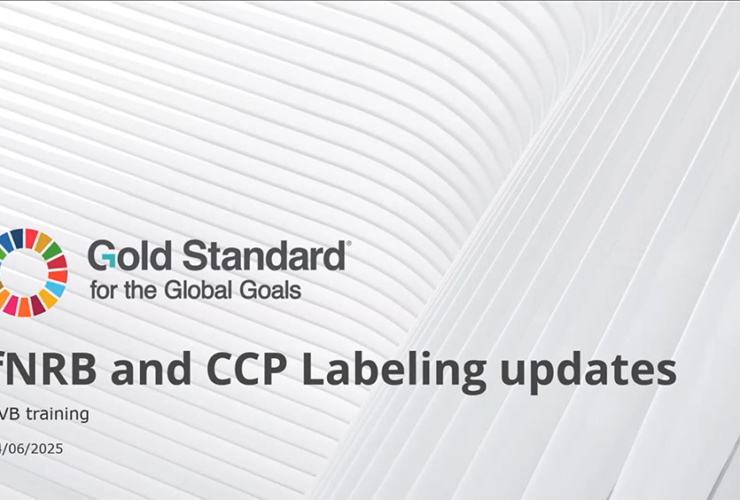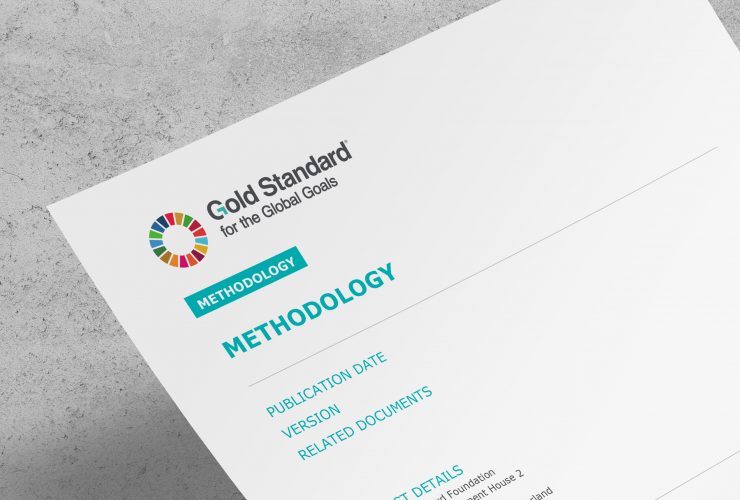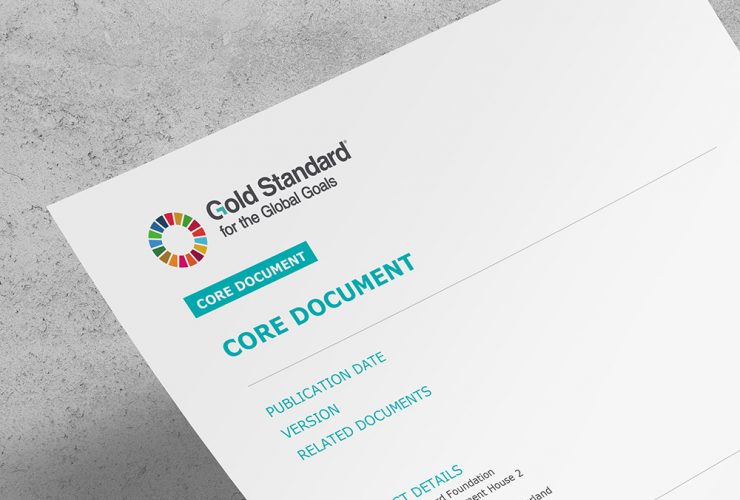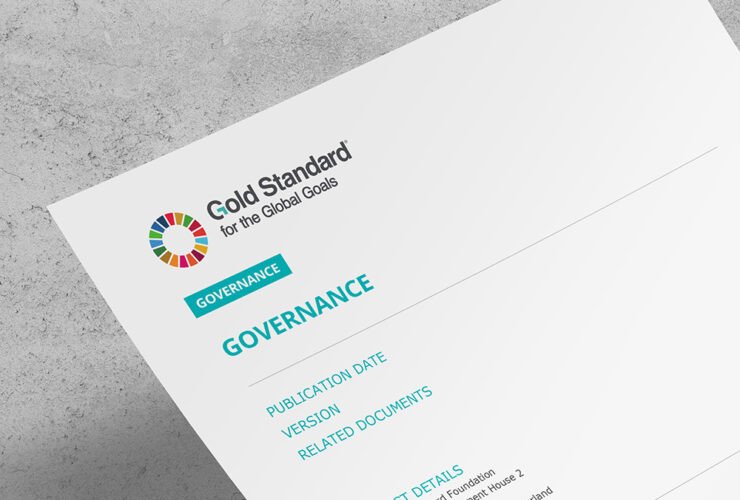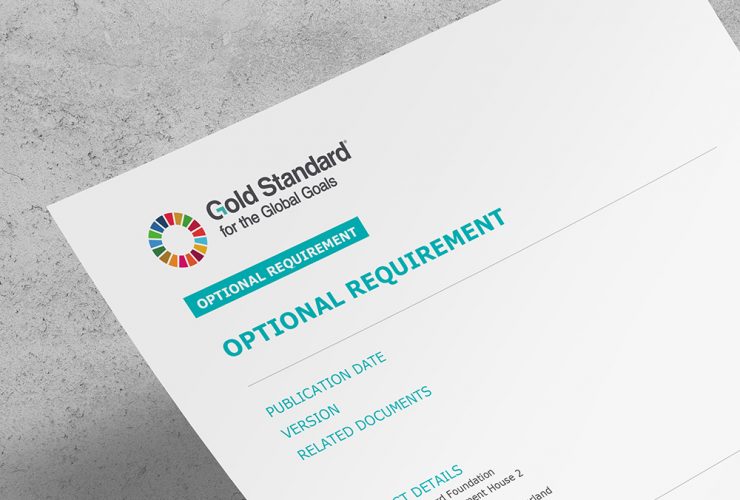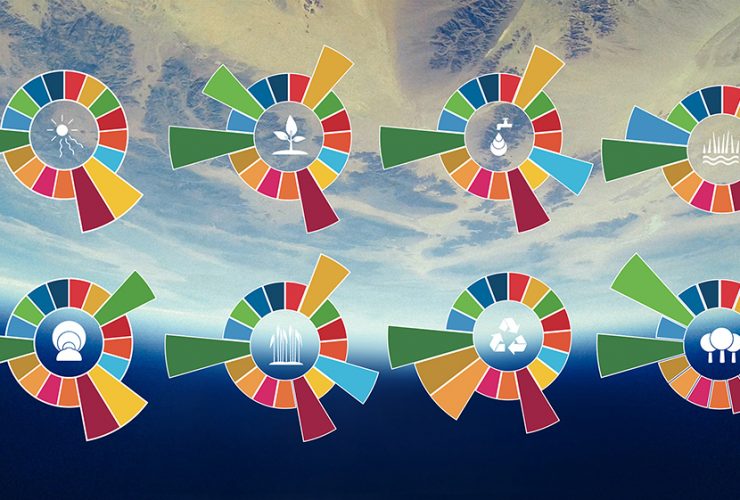In December 2024, Gold Standard published an updated fee schedule to manage the evolution of carbon markets whilst maintaining focus on mission alignment in supporting high-impact projects in countries where finance is slower to reach. The fee schedule includes a per-credit fee for transfers, retirements and cancellations as well as a fee for labelling Article 6 and CORSIA credits. These ...
Help further improve our services As part of our commitment to delivering excellent stakeholder service and building strong partnerships we are inviting project developers and other users of our standard, services, and/or applications to take part in the Gold Standard Annual Survey 2025. Your inputs play a vital role in helping us to understand what is working well and where we ...
Gold Standard hosted a webinar on 24/06/2025 for VVBs and Auditors on the recent updates to the fraction of non-renewable biomass (fNRB) and Core Carbon Principle (CCP) Labelling requirements. Here is what was covered during the session: ...
Active in Community Services Activities, Energy and waste, Land use and Forests, Carbon Capture and Storage ...
Recorded 27 May 2025 Following the success of the recent session on Social Safeguards and Auditing techniques on March 4, 2025, Gold Standard hosted a dedicated Q&A session for VVBs and Auditors. Our panel of experts answered questions related to the Gold Standard social safeguards requirements and auditing techniques. Here is what you can expect from this session: ...
This optional spreadsheet-based tool can be used alongside the Risk Assessment Report template to facilitate risk scoring calculations and support the evaluation of necessary mitigation measures. ...
Active for Energy, Waste Management and Land Use and Forestry, Community Services, and Transport project types ...
For any projects still under review with SustainCERT as of 30 April 2025, the projects will be automatically migrated to the Gold Standard Assurance Platform under the request status ‘In Preparation’. No action required for projects that have already transitioned to THE ASSURANCE PLATFORM ...
Gold Standard launched a new digital assurance platform on 5 December 2024, alongside an update to its processes to allow broader applications of its standard, Gold Standard for the Global Goals This is part of a wider digitalisation strategy and will help project developers deliver verified impact more efficiently while maintaining the integrity that Gold Standard-certified projects are known for. ...
Gold Standard, in partnership with Spatial Informatics Group (SIG), has launched the Tree and Ecosystem Monitoring Initiative (TEMI) to help advance solutions for the protection and regeneration of nature and biodiversity. The first solution to be piloted under the initiative will be the TREE-ACCURATE protocol, a tool for methodologies that use remote sensing of tree biomass to measure accuracy and ...
Gold Standard has launched a new pilot programme that will integrate digital Measurement, Reporting, and Verification (dMRV) solutions into its certification system. Running until October 2026, it will assess the potential of digital technologies to enhance the accuracy, transparency, and efficiency of monitoring and reporting for carbon credits and verified impacts under Gold Standard for the Global Goals (GS4GG). Following ...
Gold Standard for the Global Goals developments in nature activities under the Standard, including the release of a methodology for Sustainable Management of Mangroves and associated Blue Carbon and Freshwater Wetlands Activity Requirements. NEW METHODOLOGY SUSTAINABLE MANAGEMENT OF MANGROVES Gold Standard has released a bespoke solution for mangrove ecosystems with the publication of its first ever Methodology for Sustainable Management of Mangroves. This ...
Governments will be able to certify the impact of their emission reduction policies through Gold Standard, with the launch of innovative new Policy Requirements and Procedures. This initiative, currently in pilot phase, provides a route for carbon finance to support large scale climate action by allowing certification and credit issuance for emission reductions achieved through policies or regulations. The new ...
Gold Standard and the International Rice Research Institute have released a new resource hub designed to encourage and support the development of sustainable rice production activities in Vietnam and around the world by simplifying rice producers’ access to new income streams from carbon finance. The new ‘Rice Sustainability Hub’ is now available to access on the Gold Standard for the ...
Gold Standard are very pleased to announce a major step towards the digitisation of the Standard and streamlining of the certification process today. The new Gold Standard digital SDG Impact Tool for project developers and other stakeholders, and a complementary open access SDG Impact Dashboard, were released today. The new Tool streamlines the reporting, quantification, verification, and certification of the ...
Cows release methane (CH4) as a result of the digestion of feed materials in the rumen, one of the four stomach chambers of ruminant livestock. Fermentation in the rumen generates hydrogen as a result of the feed degradation by microorganisms present in the rumen. The animals must remove the produced hydrogen. One of the ways to reduce hydrogen in the ...
Traditional rice cultivation practices are both water intensive and the second largest contributor to agricultural emissions after livestock. Methane is produced when organic matter decomposes in flooded rice fields without access to oxygen. The new methodology is applicable to measures that reduce the emission of methane by: The methodology is applicable to measures that reduce anaerobic decomposition of organic matter ...
This document describes the process for reviewing, approving new methodology & methodology tool, revisions and updates to an approved methodology and methodology tool and addressing clarifications on approved methodology and tools, followed under the GS4GG. Gold Standard has revamped the methodology development procedure. Updates and new requirements including following changes. ...
The aim of the validation and verification standard is to provide a roadmap for more efficient and consistent project assessments. This document provides the requirements and procedures for Gold Standard Validation and Verification Bodies (GS VVBs) and Certification Bodies (CBs) to successfully carry out validation and verification for standalone project activities and Programme of Activities (PoAs) under Gold Standard for ...
Enabling a shift to less energy intensive modes of transport in urban environments supports decarbonisation of the transport sector, reduces air pollution and can enable better city living. This methodology applies to project activities that implement infrastructure in urban areas (such as new bicycle lanes, transport sharing programmes, bicycle parking) that support a shift to less energy intensive modes of ...
This document defines the rights, obligations, roles and responsibilities of a GS-VVB in the Gold Standard Certification Process. It is to be signed by any organisation that is or applies to become a Gold Standard Validation and Verification Body (“GS-VVB”) returned to vvb@goldstandard.org. ...
The need to undertake climate action is growing ever more urgent, with temperatures already registering 1.30C, a 50% reduction in emissions globally is required by 2030, including a cut of methane emissions by a third. The next few years are therefore critical, and we need near-term milestones and actions to help us get on track for long-term targets.To support this ...
The rule clarification provides guidance on how the positive list shall be applied to demonstrate additionality for different activities—standalone projects, Programme of Activities, and regular or real-case VPAs. ...
NEW METHODOLOGY Tech-based carbon removal and storage in recycled concrete Currently, demolished concrete is crushed into concrete aggregate before it is either used as a substitute to gravel and sand or sent to landfill. This new tech-based carbon removal methodology, developed by neustark, facilitates CO2 sequestration in demolished concrete using either direct or indirect mineral carbonation before it enters downstream processes. ...
NEW METHODOLOGY Catalysing nature-based sequestration from industrial waste This new Soil Organic Carbon (SOC) Activity Module developed by Soilfood Oy allows European-based pulp and paper manufacturing to reduce waste and remove carbon from the atmosphere by recycling the mill sludge from industrial operations. What would otherwise go to landfill or be incinerated is used to enhance soil organic matter in agriculture systems, which ...
REQUIREMENTS Updated to ensure consistency in process and improve response times to deviation requests The requirements, procedures and template for the deviation process have been updated to clarify the process and speed up responses to deviation requests. The path for requesting reconsideration of a deviation decisions has also been clarified. Related Documents Deviation Request Form v.5.0 3.05.2022 ...
REQUIREMENTS Stakeholder consultation process streamlined to make requirements more user friendly for project developers and VVBs Stakeholder consultations and meaningful engagement with those who may be affected by a project is an essential element for ensuring project success. Key updates include: More cohesive requirements for Programme of Activities (PoAs) to reduce time spent navigating multiple documents Reduction in the mandatory duration of ...
REQUIREMENTS More clarity on requirements for PoAs, scope expansion into Land Use & Forestry projects and simplifications to PoA project cycle procedures Programme of Activities enable replicable projects access to carbon finance through coordinated implementation, supporting high-impact projects that may have previously struggled to finance activities due to project size and associated transaction costs. Key updates include: New PoA hierarchy defined and corresponding rules and requirements established ...
REQUIREMENTS A step closer to supporting the creation and transfer of Internationally Transferred Mitigation Outcomes (ITMOs) under Article 6. The GHG Emissions Reduction and Sequestration Product Requirementswhich provides the specific rules for projects seeking issuance of products (i.e., GS VERs, GS CERs and PERs) has been updated to: These updates have been made based on outputs from COP26, feedback from multiple consultations, and participation within working groups ...
New template toguide the project developers in evaluating the eligibility of their projects and compiling all necessary information for a fast and successful preliminary review process. The preliminary review process gives an early indication to project developers, before resources are committed, of the eligibility of a project. This step is not a certification decision, but it helps project developers close project ...
New annex provides an alternative and less time-consuming method to monitor and calculate project fuel consumption and savings. The new SGDL model is based on code/software that has been developed by the Sea Grant Design Laboratory (SGDL) at the Massachusetts Institute of Technology (MIT). It uses regression models based on a ship’s physical characteristics and hydrodynamics, together with its speed, ...
New approach to quantify GHG impact from metered cooking devices through direct measurement of energy or fuel This new methodology applies to modern energy cooking appliances that directly measure in real-time the amount of energy or fuel used in the project scenario. This includes, but not restricted to, LPG, electric and biogas metered cookstoves, and bio-ethanol cookstoves. The methodology was developed and submitted by ClimateCare and ...
The COVID-19 Interim Measures will be further extended by six months to 30 June 2022. The interim measures will also be updated to include new requirements and procedures for physical stakeholder meetings and Stakeholder Feedback Rounds that are delayed due to the pandemic. These measures will be updated and released before the end of the year. ...
New SDG Impact Tool to more efficiently monitor, quantify and verify a project’s contributions to the SDGs, is ready for use. The Gold Standard SDG Impact Tool makes it easier and less expensive for project developers to deliver more positive impact and measure those impacts quantitively, ensuring specific and credible impact claims. Built on principles formed in the SDG Tool Guidance and piloted ...
A step-by-step guide to help project developers conduct stakeholder consultations in an effective and meaningful manner and presents guiding questions to audit and validate the stakeholder consultation process. ...
This document provides guidance on the eligibility criteria for Gold Standard VERs (GS VERs) to be supplied for use under the First Phase of the Carbon Offsetting and Reduction Scheme for International Aviation (CORSIA), as well as the process that must be followed for GS VERs to be labelled as eligible on the Gold Standard Impact Registry. ...
The purpose of this Deed is for a Project Developer to undertake that any double-claimed units shall be replaced with eligible replacement units in line with Gold Standard’s requirements, which must be supported by an approved insurance policy. ...
The key principles, guidelines and procedures to be followed for projects seeking deviation from the Gold Standard for the Global Goals (GS4GG) requirements and SDG Impact Quantification Methodologies and/or applicable methodologies. ...
This document provides the requirements and approval procedures for project developers/CMEs seeking permanent changes to the implementation, operation and/or monitoring of a certified project activity/PoA. This document was formally included as Annex-A (Design Change Approval Procedure) of the Gold Standard Principles and Requirements (version 1.2 published October 2019). ...
The document provides the minimum requirements and procedures for Gold Standard Validation and Verification Bodies (GS VVBs) and Certification Bodies (CBs) to validate and verify standalone projects and Programmes of Activities (PoAs) that apply Gold Standard for the Global Goals and all earlier versions of the standard. ...
Requirements for physical site visits and the requirements and procedures for conducting audits using remote audit techniques exclusively or in combination with physical site visits. Applicable to standalone projects of all scales. ...
This document stipulates the relationship between The Gold Standard Foundation and the VVBs. It is a mandatory legal template to be signed by all organizations applying for approval or re-approval as Gold Standard-approved Validation/Verification Bodies. ...
For VVBs to apply to become an approved auditor for Gold Standard for the Global Goals. ...
Template to document the auditing techniques used as part of the Site Visit and Remote Audit Requirements. This template is for Validation/Verification Bodies and is to be included in the validation/verification report/form. Applicable to each audit of a standalone project of any scale. ...
This document outlines the eligibility requirements for blue carbon and freshwater wetlands activities. It enables eligible activities to undergo design and performance certification, including issuance of Certified Sustainable Development Goal (SDG) Impact Statements and Products such as Gold Standard verified emission reductions/removals (GS-VERs). ...
The Risks & Capacities guidelines provide a structured framework for assessing performance risks associated with the potential non-delivery or reversal of greenhouse gas (GHG) benefits and other Sustainable Development Goal (SDG) impacts from blue carbon and freshwater wetlands (BCFW) activities. The guidelines employ a standardized risk scoring methodology that evaluates a set of predefined risk categories to identify and quantify ...
This document provides non-binding default cost of equity for Turkey to demonstrate investment analysis and additionality of project activities. Depending on the sector, project developers can select the relevant benchmark value for their proposed project activity. ...
Project developers are required to demonstrate that there are governance and management systems (GMS) in place to ensure smooth design, implementation and operation of the urban Project. The governance and management systems criteria are available in this Tool. Each of the criteria given in the Tool shall be self-assessed by the developer for a given Project as relevant. ...
The SDG assessment tool enables cities/municipalities to carry out the assessment of SDG contribution of their planned project/programme beyond what would reasonably be expected to occur in the Baseline Scenario. The programme developer will apply this tool to assess SDG contributions and identify relevant indicators to monitor actual progress made and results achieved while also providing data to communicate project's ...
This document outlines the Impact Quantification Methodology Approval Process under the Gold Standard for the Global Goals (GS4GG) ...
This template is for submission of new methodology concept as well as methodology revisions. ...
The methodology presents requirements to quantify changes in greenhouse gas (GHG) emissions and soil organic carbon (SOC) stocks through the adoption of improved agricultural practices. Activities can achieve avoidance of emissions as well as sequestration of carbon in the soil, both which result in increased SOC content. ...
This Soil Organic Carbon (SOC) Activity Module focuses on zero tillage/no-till practice, an agricultural technique for growing crops or pasture without mechanically disturbing the soil through tillage (including disturbance from non-turning tillage such as rippers and disc harrows). ...
This Soil Organic Carbon (SOC) Activity Module presents requirements and guidance to quantify and monitor greenhouse gas (GHG) emissions and soil organic carbon (SOC) changes resulting from change in soil management practices within agricultural systems through application of biostimulants for soil revitalisation. The eligible activities are intended to achieve net carbon sequestration in the soil carbon pool. This activity module ...
This module focuses on defining, monitoring, and reporting the improved management of pasture. Although the module was developed for managed pastures in dairy production in Finland, it is applicable regionally in the EU. ...
Provides guidance for the development and the procedure for approval of Activity Modules under the Soil Organic Carbon (SOC) Framework Methodology. ...
This Soil Organic Carbon (SOC) Activity Module presents the requirements and guidance to quantify greenhouse gas (GHG) emissions from agriculture by changing soil tillage practices within agricultural systems. This SOC Activity Module is based on and replaces the Gold Standard Agriculture Methodology for Increasing Soil Carbon Through Improved Tillage Practices V0.9. ...
This Soil Organic Carbon (SOC) Activity Module presents requirements and guidance to monitor and calculate the climate impact of the application of organic soil improvers from pulp and paper mill sludges. ...
This activity Module focuses on cover crops planted to cover the bare soil during fallow periods to increase soil organic carbon (SOC). It is applicable globally. ...
Template required to help calculate GHG sequestration from Afforestation/Reforestation projects ...
Includes the set of templates required to help calculate GHG sequestration from Afforestation/Reforestation projects. ...
Methodology for projects seeking to quantify GHG Emissions Reductions & Sequestration from Afforestation/Reforestation (A/R) activities. Used in conjunction with the GHG Emissions Reduction & Sequestration Product Requirements projects may be issued with carbon credits. ...
The methodology is applicable to measures that reduce anaerobic decomposition of organic matter in rice-cropping soils. Such measures include changing the water regime during the cultivation period. This methodology can be applied to large and small-scale or micro-scale projects or PoAs. ...
This methodology provides the approaches for estimating carbon removals from the reforestation of mangrove ecosystems. This includes the planting of mangroves in areas that historically supported mangrove ecosystems. ...
Gold Standard has approved the requirements to apply CDM Methodology AMS-III.AU “Methane emission reduction by adjusted water management practice in rice cultivation” for Gold Standard Certification. ...
Cows release methane (CH4) as a result of the digestion of feed materials in the rumen, one of the four stomach chambers of ruminant livestock. Fermentation in the rumen generates hydrogen as a result of the feed degradation by microorganisms present in the rumen. The animals must remove the produced hydrogen. One of the ways to reduce hydrogen in the ...
The methodology quantifies the reduction of methane (CH4) emissions from enteric fermentation for dairy cows as well as impacts on emissions from manure handling. The methodology focuses on application of feed supplements to directly inhibit methanogenesis. ...
Top soil erosion is one of the main drivers of land degradation. Agricultural lands with declining soil organic matter face reductions in the water infiltration capacity of soil, leading to increased run-off and further topsoil erosion. This methodology quantifies the water benefits created when adopting sustainable agricultural land management practices (SALM) that mitigate soil erosion. ...
This template has been created to help to collect baseline and monitoring data for methodology application. The template is for guidance purposes and its use is not mandatory. ...
This tool is designed to quantify the uncertainty for the methodology application. ...
Applicable to projects and programmes that seek to introduce zero or low GHG water purification systems to provide safe drinking water, this methodology quantifies GHG emissions reductions displaced through decentralised thermal energy technologies. Used in conjunction with the GHG Emissions Reduction & Sequestration Product Requirements, projects and programmes applying this methodology may be issued with GSVERs. ...
This is an ER calculation tool for community water supply projects, which can be used by PDs applying Methodology "Emission Reductions from Safe Drinking Water Supply" ...
This is an ER calculation tool for household level water treatment technologies, which can be used by PDs applying Methodology "Emission Reductions from Safe Drinking Water Supply" ...
This is baseline survey questionnaire for community water supply projects, which can be used by PDs applying Methodology "Emission Reductions from Safe Drinking Water Supply" ...
This is a baseline survey questionnaire for household level water treatment technologies, which can be used by PDs applying Methodology "Emission Reductions from Safe Drinking Water Supply" ...
This is a household survey questionnaire for community water supply projects, which can be used by PDs applying Methodology "Emission Reductions from Safe Drinking Water Supply" ...
This is a household survey questionnaire for household level water treatment technologies, which can be used by PDs applying Methodology "Emission Reductions from Safe Drinking Water Supply" ...
This is a project survey questionnaire for community water supply projects, which can be used by PDs applying Methodology "Emission Reductions from Safe Drinking Water Supply" ...
This is a project survey questionnaire for household level water treatment technologies, which can be used by PDs applying Methodology "Emission Reductions from Safe Drinking Water Supply" ...
This is a usage survey questionnaire for community water supply projects, which can be used by PDs applying Methodology "Emission Reductions from Safe Drinking Water Supply" ...
This is a usage survey questionnaire for household level water treatment technologies, which can be used by PDs applying Methodology "Emission Reductions from Safe Drinking Water Supply" ...
This is a water consumption field test questionnaire for community water supply projects, which can be used by PDs applying Methodology "Emission Reductions from Safe Drinking Water Supply" ...
This is a water consumption field test questionnaire for household level water treatment technologies, which can be used by PDs applying Methodology "Emission Reductions from Safe Drinking Water Supply" ...
It is a survey questionnaire for PDs applying the Methodology for Metered and Measured Energy Cooking Devices V1.0 ...
It is a tool for calculating emission reductions for PDs applying the Methodology for Metered and Measured Energy Cooking Devices V1.0 ...
This methodology applies to the activities that involve recovery and use of methane from manure and agricultural wastes that would be decaying anaerobically, emitting methane to the atmosphere, in the absence of the implemented activity ...
Methodology for projects seeking to quantify GHG Emissions Reductions from projects that displace decentralized thermal energy technologies. Used in conjunction with the GHG Emissions Reduction & Sequestration Product Requirements projects may be issued with carbon credits. ...
The methodology applies to project activities, which comprise elevator operation and the application of regenerated energy resulting from the elevator’s regenerative energy potential to achieve emissions reduction. It integrates the Battery Management System and Energy Management System for efficient energy control and dispatch from the elevator(s) to the whole building. ...
This is a KPT result analyser for project using multiple fuels and applying TPDDTEC methodology ...
This is a KPT result analyser for project using single fuel and applying TPDDTEC methodology ...
This is a survey questionnaire for project applying TPDDTEC ...
This is an ER tool for TPDDTEC methodology ...
This tool is applicable for the project with single project scenario. In case the Project Developer has more than 1 type of project scenario (e.g., project stove which are 5% different in absolute term, the Project Developer could (1) create different files for different project scenarios OR (2) Copy the tab "ER schedule per month) but edit the input parameters ...
This methodology applies to modern energy cooking appliances that directly measure in real-time the amount of energy or fuel consumed in households, communities, and/or institutions such as schools, prisons or hospitals. This includes, but not restricted to, LPG, electric and biogas metered cookstoves, and bio-ethanol cookstoves. ...
This technical reference manual aims to assist project developers and practitioners in applying the Gold Standard Methodology to Estimate and Verify ADALYs from Cleaner Household Air. While the specific requirements and guidelines are laid out in the ADALYs methodology, this document serves as a supplementary guide to support the successful implementation of the methodology. The manual also provides information on ...
The methodology is applicable to projects that implement shore-side or offshore electricity supply for ships while they are docked at berths or offshore. The use of onshore or offshore sources, such as specially designed buoys, to provide electricity replace the need for ships' fossil-fuel auxiliary power generators. ...



